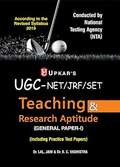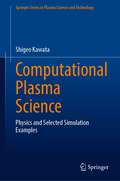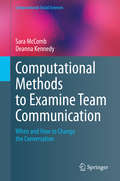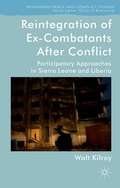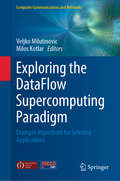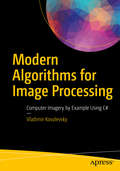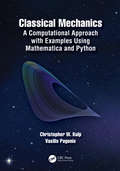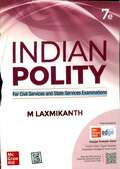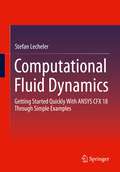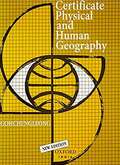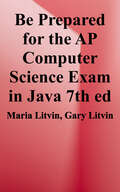Special Collections
Competitive Exam
- Table View
- List View
Upkar’s Corporation Bank Recruitment Exam - competitive exam
by T. S. JainEligibility, age and other conditions and papers on ability, aptitude and language.
Upkar’s IGNOU B. Ed. Entrance Exam - competitive exam - IGNOU
by T. S. Jain and M. B. LalModel papers for students pursuing course for IGNOU B. Ed. Entrance Exam with solved papers of previous year exams.
Upkar’s Railway Recruitment Board Examination - competitive exam
by T. S. Jain and M. B. LalObjective Arithmetic, General Intelligence, General Knowledge, General Science and Objective General English question papers with answers of 2006/7/8/9 to help candidates to appear for railway recruitment board exams in 2010 for different positions.
Upkar's Staff Selection Commission
by T. S. Jain and M. B. LalExamination question papers and their answers to prepare for future staff selection commission tests.
Upkar's Teaching and Research Aptitude - competitive exam
by T. S. Jain and K. C. Vashistha and M. B. LalModel paper and references for teaching and research aptitude as per revised syllabus.
Computational Plasma Science
by Shigeo KawataThe book presents fundamentals of plasma physics with rich references and computational techniques in a concise manner. It particularly focuses on introductions to numerical simulation methods in plasma physics, in addition to those to physics and mathematics in plasma physics. It also presents the fundamentals of numerical methods, which solve mathematical models of plasmas, together with examples of numerical results. A discretization method, the so-called finite difference method, is introduced for particle-in-cell methods and fluid codes, which have been widely employed in plasma physics studies. In addition to the introduction to numerical solutions, it also covers numerical stability. The instabilities and numerical errors significantly influence the results, and for correct results, great efforts are required to avoid such numerical artifacts. The book also carefully discusses the numerical errors, numerical stability, and uncertainty in numerical computations. Readers are expected to have an understanding of fundamental physics of mechanics, electromagnetism, thermodynamics, statistical physics, relativity, fluid dynamics, and mathematics, but the book does not assume background knowledge on plasma. Therefore, it is a first book of plasma physics for upper undergraduate and early graduate students who are interested in learning it.
Computational Plasma Science
by Shigeo KawataThe book presents fundamentals of plasma physics with rich references and computational techniques in a concise manner. It particularly focuses on introductions to numerical simulation methods in plasma physics, in addition to those to physics and mathematics in plasma physics. It also presents the fundamentals of numerical methods, which solve mathematical models of plasmas, together with examples of numerical results. A discretization method, the so-called finite difference method, is introduced for particle-in-cell methods and fluid codes, which have been widely employed in plasma physics studies. In addition to the introduction to numerical solutions, it also covers numerical stability. The instabilities and numerical errors significantly influence the results, and for correct results, great efforts are required to avoid such numerical artifacts. The book also carefully discusses the numerical errors, numerical stability, and uncertainty in numerical computations. Readers are expected to have an understanding of fundamental physics of mechanics, electromagnetism, thermodynamics, statistical physics, relativity, fluid dynamics, and mathematics, but the book does not assume background knowledge on plasma. Therefore, it is a first book of plasma physics for upper undergraduate and early graduate students who are interested in learning it.
Computational Methods to Examine Team Communication
by Sara McComb and Deanna KennedyThe primary focus of this book is an examination of longitudinal team communication and its impact on team performance. This theoretically-grounded, holistic examination of team communication includes cross-condition comparisons of team (i.e., distributed/in person, unrestricted/time pressured, two performance episodes) and employs multiple quantitative methodological approaches to examine the phenomena of interest. This book simultaneously provides practical content for researchers and practitioners in the social sciences and humanities. Included are step-by-step instructions for the methodologies employed, and distillations of findings via Managerial Minutes that highlight best practices and/or examples to help enhance team communication in practice.
Computational Methods to Examine Team Communication
by Sara McComb and Deanna KennedyThe primary focus of this book is an examination of longitudinal team communication and its impact on team performance. This theoretically-grounded, holistic examination of team communication includes cross-condition comparisons of team (i.e., distributed/in person, unrestricted/time pressured, two performance episodes) and employs multiple quantitative methodological approaches to examine the phenomena of interest. This book simultaneously provides practical content for researchers and practitioners in the social sciences and humanities. Included are step-by-step instructions for the methodologies employed, and distillations of findings via Managerial Minutes that highlight best practices and/or examples to help enhance team communication in practice.
Reintegration of Ex-Combatants After Conflict
by Walt KilroyReintegration programmes for ex-combatants are supposed to support the wider peace process. This study looks at the way they were carried out in Sierra Leone and Liberia and assesses the degree to which they were conducted in a participatory way. To a large extent, ex-combatants felt that they had received unreliable information and had been afforded little input in the process. Others, whose experience had been more participatory, were faring better in terms of work, economic situation andcommunity relations. Reintegration of Ex-Combatants After Conflict is based on detailed interviews with a wide range of stakeholders, and on a survey and focus group discussions with ex-combatants. Their voices are clearly heard, in both the qualitative and quantitative data. Kilroy explores the important implications for the effect of reintegration programmes on the wider peacebuilding project. Social capital, which affects the peace process, is also highlighted, as the extent to which this can be created or undermined depends on the way the programmes were conducted. Kilroy's insightful study will appeal to all those with an interest in conflict resolution, post-war recovery, and development.
Exploring the DataFlow Supercomputing Paradigm
by Veljko Milutinovic and Milos KotlarThis useful text/reference describes the implementation of a varied selection of algorithms in the DataFlow paradigm, highlighting the exciting potential of DataFlow computing for applications in such areas as image understanding, biomedicine, physics simulation, and business.The mapping of additional algorithms onto the DataFlow architecture is also covered in the following Springer titles from the same team: DataFlow Supercomputing Essentials: Research, Development and Education, DataFlow Supercomputing Essentials: Algorithms, Applications and Implementations, and Guide to DataFlow Supercomputing.Topics and Features: introduces a novel method of graph partitioning for large graphs involving the construction of a skeleton graph; describes a cloud-supported web-based integrated development environment that can develop and run programs without DataFlow hardware owned by the user; showcases a new approach for the calculation of the extrema of functions in one dimension, by implementing the Golden Section Search algorithm; reviews algorithms for a DataFlow architecture that uses matrices and vectors as the underlying data structure; presents an algorithm for spherical code design, based on the variable repulsion force method; discusses the implementation of a face recognition application, using the DataFlow paradigm; proposes a method for region of interest-based image segmentation of mammogram images on high-performance reconfigurable DataFlow computers; surveys a diverse range of DataFlow applications in physics simulations, and investigates a DataFlow implementation of a Bitcoin mining algorithm.This unique volume will prove a valuable reference for researchers and programmers of DataFlow computing, and supercomputing in general. Graduate and advanced undergraduate students will also find that the book serves as an ideal supplementary text for courses on Data Mining, Microprocessor Systems, and VLSI Systems.
Exploring the DataFlow Supercomputing Paradigm
by Veljko Milutinovic and Milos KotlarThis useful text/reference describes the implementation of a varied selection of algorithms in the DataFlow paradigm, highlighting the exciting potential of DataFlow computing for applications in such areas as image understanding, biomedicine, physics simulation, and business. The mapping of additional algorithms onto the DataFlow architecture is also covered in the following Springer titles from the same team: DataFlow Supercomputing Essentials: Research, Development and Education, DataFlow Supercomputing Essentials: Algorithms, Applications and Implementations, and Guide to DataFlow Supercomputing. Topics and Features: introduces a novel method of graph partitioning for large graphs involving the construction of a skeleton graph; describes a cloud-supported web-based integrated development environment that can develop and run programs without DataFlow hardware owned by the user; showcases a new approach for the calculation of the extrema of functions in one dimension, by implementing the Golden Section Search algorithm; reviews algorithms for a DataFlow architecture that uses matrices and vectors as the underlying data structure; presents an algorithm for spherical code design, based on the variable repulsion force method; discusses the implementation of a face recognition application, using the DataFlow paradigm; proposes a method for region of interest-based image segmentation of mammogram images on high-performance reconfigurable DataFlow computers; surveys a diverse range of DataFlow applications in physics simulations, and investigates a DataFlow implementation of a Bitcoin mining algorithm. This unique volume will prove a valuable reference for researchers and programmers of DataFlow computing, and supercomputing in general. Graduate and advanced undergraduate students will also find that the book serves as an ideal supplementary text for courses on Data Mining, Microprocessor Systems, and VLSI Systems.
Modern Algorithms for Image Processing
by Vladimir KovalevskyUtilize modern methods for digital image processing and take advantage of the many time-saving templates provided for all of the projects in this book.
Modern Algorithms for Image Processing approaches the topic of image processing through teaching by example. Throughout the book, you will create projects that resolve typical problems that you might encounter in the world of digital image processing. Some projects teach you methods for addressing the quality of images, such as reducing random errors or noise and suppressing pulse noise (salt and pepper), a method valuable for improving the quality of historical images. Other methods detail how to correct inhomogeneous illumination, not by means of subtracting the mean illumination, but through division, a far more efficient method. Additional projects cover contrasting, and a process for edge detection, more efficient than Canny's, for detecting edges in color images directly, without converting them into black and white images.
What You'll Learn:
Who This Book Is For:
C# developers who work with digital image processing or are interested in informatics. The reader should have programming experience and access to an integrated development environment (IDE), ideally .NET.
This book does not prove or disprove theorems, but suggests methods for learning valuable concepts that will enable you to customize your own image processing projects.
Modern Algorithms for Image Processing
by Vladimir KovalevskyUtilize modern methods for digital image processing and take advantage of the many time-saving templates provided for all of the projects in this book.Modern Algorithms for Image Processing approaches the topic of image processing through teaching by example. Throughout the book, you will create projects that resolve typical problems that you might encounter in the world of digital image processing. Some projects teach you methods for addressing the quality of images, such as reducing random errors or noise and suppressing pulse noise (salt and pepper), a method valuable for improving the quality of historical images. Other methods detail how to correct inhomogeneous illumination, not by means of subtracting the mean illumination, but through division, a far more efficient method. Additional projects cover contrasting, and a process for edge detection, more efficient than Canny's, for detecting edges in color images directly, without converting them into black and white images.What You'll LearnApply innovative methods for suppressing pulse noise, enhancing contrast, and edge detectionKnow the pros and cons of enlisting a particular methodUse new approaches for image compression and recognizing circles in photosUtilize a valuable method for straightening photos of paintings taken at an oblique angle, a critical concept to understand when using flash at a right angleUnderstand the problem statement of polygonal approximation of boundaries or edges and its solutionUse a new method for detecting bicycles in trafficAccess complete source code examples in C# for all of the projectsWho This Book Is ForC# developers who work with digital image processing or are interested in informatics. The reader should have programming experience and access to an integrated development environment (IDE), ideally .NET.This book does not prove or disprove theorems, but suggests methods for learning valuable concepts that will enable you to customize your own image processing projects.
Classical Mechanics
by Vasilis Pagonis and Christopher W. KulpClassical Mechanics: A Computational Approach with Examples using Python and Mathematica provides a unique, contemporary introduction to classical mechanics, with a focus on computational methods. In addition to providing clear and thorough coverage of key topics, this textbook includes integrated instructions and treatments of computation. Full of pedagogy, it contains both analytical and computational example problems within the body of each chapter. The example problems teach readers both analytical methods and how to use computer algebra systems and computer programming to solve problems in classical mechanics. End-of-chapter problems allow students to hone their skills in problem solving with and without the use of a computer. The methods presented in this book can then be used by students when solving problems in other fields both within and outside of physics. It is an ideal textbook for undergraduate students in physics, mathematics, and engineering studying classical mechanics. Features: Gives readers the "big picture" of classical mechanics and the importance of computation in the solution of problems in physics Numerous example problems using both analytical and computational methods, as well as explanations as to how and why specific techniques were used Online resources containing specific example codes to help students learn computational methods and write their own algorithms A solutions manual is available via the Routledge Instructor Hub and extra code is available via the Support Material tab
Classical Mechanics
by Vasilis Pagonis and Christopher W. KulpClassical Mechanics: A Computational Approach with Examples using Python and Mathematica provides a unique, contemporary introduction to classical mechanics, with a focus on computational methods. In addition to providing clear and thorough coverage of key topics, this textbook includes integrated instructions and treatments of computation. Full of pedagogy, it contains both analytical and computational example problems within the body of each chapter. The example problems teach readers both analytical methods and how to use computer algebra systems and computer programming to solve problems in classical mechanics. End-of-chapter problems allow students to hone their skills in problem solving with and without the use of a computer. The methods presented in this book can then be used by students when solving problems in other fields both within and outside of physics. It is an ideal textbook for undergraduate students in physics, mathematics, and engineering studying classical mechanics. Features: Gives readers the "big picture" of classical mechanics and the importance of computation in the solution of problems in physics Numerous example problems using both analytical and computational methods, as well as explanations as to how and why specific techniques were used Online resources containing specific example codes to help students learn computational methods and write their own algorithms A solutions manual is available via the Routledge Instructor Hub and extra code is available via the Support Material tab
Samkaleen Pashchatya Darshan - Competitive Exam
by Basant Kumar Lalप्रस्तुत पुस्तक में सामान्यतः बीसवीं शताब्दी के कुछ प्रमुख दार्शनिक विचारों का परिचय मिलता है। पाश्चात्य विचाराकों में एफ. एच. ब्रैडले ने आभास और सत् की समस्या पर विचार किया है इसके भेद को स्पष्ट रूप से समझाने का प्रयास किया है। चार्ल्स सैन्डर्स ने संशय, विश्वास एवं अन्वेषण पर टिप्पणी की। अमरीकी वास्तवाद, के भेद एवं उसके अर्थ को स्पष्ट किया है। हेनरी बर्गसां ने सत् का स्वरूप सर्जनात्मक विकसासवाद प्रज्ञा एवं अन्तर्दृष्टि के बारे में बताया है। मूर तथा रसेल ने ज्ञानमीमांसीय विचार को महत्व दिया है। जिससे जगत के बारे में क्या जाना जा सकता है। अल्फ्रेड नार्थ ह्वाइटहेड ने दार्शनिक चिन्तन का स्वरूप, वैचारिक कोट की व्यवस्था की पहचान, वास्तविक तत्व शाश्वत वस्तु के सहयोग से जगत प्रक्रिया ईश्वर विचार आदि विषयों पर विचार किया है।लुडविग विटगेन्स्टीन ने विकसित दर्शन, विकसित विचार और गिलबर्ट राइल ने विश्लेषणात्मक दर्शन पर अपने विचार प्रस्तुत किये है।इस प्रकार पाश्चात्य दार्शनिक विचारकों ने अलग अलग विषय पर जो अपने विचार व्यक्त किये है उससे इस पुस्तक की अपनी एक अलग पहचान है और पढ़ने वालों को सही जानकारी मिलती है।
Indian Polity - Competitive Exam
by M LaxmikanthThe "INDIAN POLITY 7th Edition" by M LAXMIKANTH is a comprehensive guide tailored for aspirants of India's Civil Services and State Services Examinations. The book breaks down the intricate facets of Indian Polity into digestible sections. In the preliminary examination section, it covers the broad spectrum of Indian governance, including the Constitution, Political System, Panchayati Raj, and Rights Issues. The main examination section delves deeper, discussing the historical underpinnings and evolution of the Indian Constitution, the functions and responsibilities of Union and States, and comparisons with other global constitutional schemes. Additionally, the book offers insights into the dynamics of coalition politics, emphasizing its fluid nature, the significance of compromise, and the challenges of operating on a minimum program. This edition serves as an essential resource, aiding students in navigating both preliminary and main stages of their examination journey.
Computational Fluid Dynamics
by Stefan LechelerThis textbook and exercise book is aimed at future users of computational fluid dynamics software. In addition to the comprehensibly presented basics, the focus is on technical examples treated in detail with supplementary practical hints. Comprehension questions including applications give the beginner confidence in fundamental relationships. The original 4th German edition has been adapted to the latest program version ANSYS 18.1.
Computational Fluid Dynamics
by Stefan LechelerThis textbook and exercise book is aimed at future users of computational fluid dynamics software. In addition to the comprehensibly presented basics, the focus is on technical examples treated in detail with supplementary practical hints. Comprehension questions including applications give the beginner confidence in fundamental relationships. The original 4th German edition has been adapted to the latest program version ANSYS 18.1.
Be Prepared for the AP Computer Science Exam in Java
by Maria Litvin and Gary LitvinBe Prepared is a comprehensive test preparation book for Advanced Placement* examination in computer science. It includes a thorough review section that describes exam format and requirements, C++ subset used in the exams, and exam topics for both A- and AB-level exams. It also includes over fifty multiple-choice questions with complete solutions that show effective strategies and shortcuts.
The second part of the book contains four complete practice exams with answers and solutions (two A and two AB exams, with no overlap). The companion web site for this book contains annotated solutions to free-response questions from past exams, review and practice questions for this year's required Case Study, and links to the College Board's materials and other resources on the web. The book is written by Maria Litvin, a veteran computer science teacher, College Board consultant, leader of workshops, and the author of a popular textbook for high school AP computer science courses. Four teachers from two leading schools with nationally-recognized computer science programs contributed questions for practice exams.

